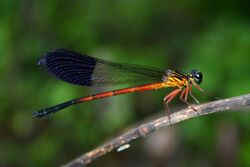Biology:Euphaea cardinalis
| Euphaea cardinalis | |
|---|---|

| |
| Male | |
| Scientific classification | |
| Domain: | Eukaryota |
| Kingdom: | Animalia |
| Phylum: | Arthropoda |
| Class: | Insecta |
| Order: | Odonata |
| Suborder: | Zygoptera |
| Family: | Euphaeidae |
| Genus: | Euphaea |
| Species: | E. cardinalis
|
| Binomial name | |
| Euphaea cardinalis (Fraser, 1924)
| |
| Synonyms | |
| |
Euphaea cardinalis,[2][1] Travancore torrent dart,[3][4] is a species of damselfly in the family Euphaeidae.[1]
This species was considered endemic to the Western Ghats (Fraser, 1934) and it was known to occur only in south of the Palghat Gap.[5] But it was collected from Assam in 1979 (Mitra 2002).[1][6]
Description and habitat
It is a medium-sized damselfly with black head and brown-capped pale grey eyes. Its thorax is black, marked with bright ochreous-red antehumeral and humeral stripes. Lateral sides of the thorax in the base is red. Its all legs are red. Wings are broader than Euphaea dispar. Fore-wings are transparent, merely enfumed with brown on the apices and almost in same length of the abdomen. Hindwings are transparent; but nearly half of the wings from the apices are broadly black. The black area of wings has steely-blue reflections in some lights. Abdomen is bright red up to the segment 6; apical third of segment 6 to the end segment are black. Anal appendages are black.[5]
Female is short and robust; the ochreous-red of male is replaced with yellow colors. All wings are transparent, enfumed with black in adults. Abdomen is black with yellow lateral stripes up to segment 6. The yellow lateral stripes continued to segment 7. Segment 8 has a narrow and 9 has a broad yellow apical annule, covering dorsal half.[5]
They breed in hill streams and usually find perched on boulders and riparian vegetation of streams.[5][7][8][3][4]
See also
- List of odonates of India
- List of odonata of Kerala
References
- ↑ 1.0 1.1 1.2 1.3 Kakkasery, F.; Mitra, A. (2010). "Euphaea cardinalis". IUCN Red List of Threatened Species 2010: e.T175194A7120246. doi:10.2305/IUCN.UK.2010-4.RLTS.T175194A7120246.en. https://www.iucnredlist.org/species/175194/7120246. Retrieved 19 November 2021.
- ↑ "World Odonata List". University of Puget Sound. https://www.pugetsound.edu/academics/academic-resources/slater-museum/biodiversity-resources/dragonflies/world-odonata-list2/.
- ↑ 3.0 3.1 "Euphaea cardinalis Fraser, 1924". India Biodiversity Portal. http://indiabiodiversity.org/species/show/266708.
- ↑ 4.0 4.1 "Euphaea cardinalis Fraser, 1924". Odonata of India, v. 1.00. Indian Foundation for Butterflies. http://www.indianodonata.org/sp/278/Euphaea-cardinalis.
- ↑ 5.0 5.1 5.2 5.3 C FC Lt. Fraser (1934). The Fauna of British India, including Ceylon and Burma, Odonata Vol. II. Red Lion Court, Fleet Street, London: Taylor and Francis. pp. 108-110. https://archive.org/details/FraserOdonata2.
- ↑ K.A., Subramanian; K.G., Emiliyamma; R., Babu; C., Radhakrishnan; S.S., Talmale (2018). Atlas of Odonata (Insecta) of the Western Ghats, India. Zoological Survey of India. pp. 84–85. ISBN 9788181714954.
- ↑ C FC Lt. Fraser (1924). A Survey of the Odonate (Dragonfly) Fauna of Western India and Descriptions of Thirty New Species. pp. 512–513. http://faunaofindia.nic.in/PDFVolumes/records/026/05/0423-0522.pdf.
- ↑ Subramanian, K. A. (2005). Dragonflies and Damselflies of Peninsular India - A Field Guide. http://www.ias.ac.in/Publications/Overview/Dragonflies.
External links
Wikidata ☰ Q610841 entry
 |


